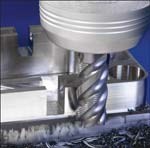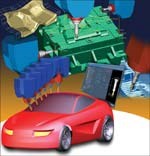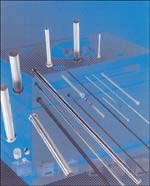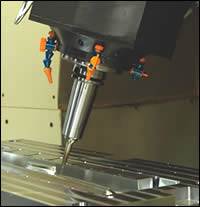Post-Show Highlights — The Need For Speed
The show's racing theme was no accident as exhibitors and presenters showed the latest products, equipment and strategies designed to speed up the mold design and build process so moldmakers can win the race for better leadtimes.
Exhibitors pulled out all of the stops at this year's MoldMaking Expo 2005—held at the Donald E. Stephens Convention Center in Rosemont, IL, from April 19-21—by rolling out the latest technologies for the mold designer, tooling engineer and moldmaker to examine up close and personal. In addition to speed being a key component on the trade show floor, the focus also was on continuous improvement. Over the past year, suppliers have closely examined their current equipment and technology for ways to make it work better and more efficiently.
The mood at this year's Expo was decidedly upbeat as the industry is currently in an upward mode. Moldmakers spent their time at the show gleaning words of wisdom from industry experts on the shop floor and at the conference program. Most often heard on the show floor was advice like, "Focus on process—not products—to improve operations," "Determine what you do best and make it better, find your niche in the industry and complement your services by leveraging suppliers both domestic and abroad," and "Embrace new technology and new business models to survive." Moldmakers seem up to the challenge posed by foreign competition—with some embracing the East (China/India) into both marketing and manufacturing strategies.
There was a continued emphasis on lean manufacturing through "lights out" or unattended machining, automation of setups, modular workpiece fixtures, efficient and optimized cutting tools, using off-the-shelf sub-assemblies and software tools, and strategic outsourcing. Hard machining came into play, and this area should continue to grow as technology gives moldmakers more viable ways to accomplish this. Software suppliers are offering products to blend the two together.
This year, the show co-located with the Quality Expo—offering attendees the opportunity to see the latest inspection automation equipment. On display was everything from CMMs to vision systems, ISO registrars to inspection laboratories, and almost anything in between. The ISO mantra—better quality through documented procedures yields higher profits—should have had every savvy mold builder come away with ideas on how to minimize repetitive setups and increase accuracy while driving profits up and direct labor costs down. If moldmakers intend to fully automate the mold manufacturing process and get away from the moldmaking process, the right setup and inspection equipment must be in place.
Here is the latest in product and equipment offerings—as well as the latest trends—straight from the trade show floor and conference program.
Software
Speed in design and speed in machining were key buzzwords in the CAD/CAM booths. From rapid finishing passes with intelligent re-machining routines to ready application of torcoidal milling and plunge milling for roughing, software suppliers have made huge strides to keep up with machine tool manufacturers' latest technologies.
Five-axis machining is another key area of growth, and CAM software is starting to address mold designers' unique needs in their five-axis machining modules—specifically providing programs to allow the mold designer to mill the entire part in five axis. This allows them to use the shortest tool length possible instead of using progressively longer tools for deep areas in a three-axis only milling environment.
Additionally, increased sales of higher tolerance HSM centers have forced CAM companies to adjust their milling algorithms to allow for higher quality surface finishes. Point density and point distribution across contoured faces becomes very important to surface finish. Moldmakers are using machining tolerances and stepovers tighter today than at any time in the past. This means less polishing of the mold component once it comes off the mill.
A few software companies have gone the extra mile and aligned themselves with a machine tool vendor or two. No longer is the standard line "We can do all things for all people." Instead, it has been replaced with "We focus on one segment of machining and only one—and by doing that we can be the very best at it.
Cutting Tools
Once again, speed was the hot issue at all of the cutting tool booths, along with a focus on increased speeds and feeds and deeper depths-of-cut in tougher to machine materials. New offerings included insert-able carbides, solid carbides, high speeds, coated and uncoated cutters from around the world—and each cutting tool exhibitor had its own special twist on the helical flute generation and cutting tooth geometry. Many of the cutting tool manufacturers are developing tools that perform much better in stainless steel, titanium, and other hi-temp alloys. With the advancement of carbide grades, cutting tool geometries and tool coatings, this is becoming easier to achieve. As long as machine tool builders continue to develop machines with higher capabilities, cutting tool manufacturers will have to do the same to keep up.
The past year has seen cutting tool manufacturers spending countless hours in shops across the country testing and researching the various geometries when applied with high-performance machining centers to find the optimum conditions for surface definition and cutter life. A recurring theme was that all cutters are not created equally—and so the moldmaker, programmer and cutter supplier must work together to find the right tool for the right job—simply having the correct cutter and speed/feed for a specific application isn't adequate. Toolholders are more rigid to provide interface for the cutter to the machine.
Important questions were posed by moldmakers: How fast can we make the chips and how accurately can we maintain the workpiece. Again—per cutting tool manufacturers—it is all about finding exactly the correct cutter for exactly the right application.
Machine Tools
While this has been the first time in several years that there weren't any major advances in EDM, turning or milling machines, once again speed played a major role in equipment manufacturers' tweaking their current offerings: moldmakers need to save time by saving setup time and increasing their bottom line. The higher level of CNC in the machine tool market is making a big impact on the accuracies and speeds of production. Tools that can mill harder materials faster were evident; and milling machines are being made faster and more accurate.
There were a few new machines from Germany, Switzerland and Italy—with a cartridge-style spindle, which is capable of roughing and then automatically changing to a high-speed spindle for finish machining without moving the workpiece; and a couple of new joint ventures between machine tool manufacturers were announced.
Two emerging technologies were quite evident on the show floor this year. The number of laser engraving machines on display was up from last year—indicating a competitive market for this service in North America. A number of exhibitors have now added laser engraving capabilities to their repertoire. Laser welding machines also were seen. Although the technology itself is not new, a line of highly adaptable laser welding equipment was rolled out and recommended for use in the mold building process. Laser welding machine manufacturers pointed out that through laser application of the welding rod, the mold build/repair facility is able to apply the needed material without a large "heat-affected" zone—which leads to greater application in engineering changes and dissimilar material joining, as well as non-traditional welding of mold materials.
Components
The theme of speed carried through to the mold components manufacturers and suppliers. They offered a plethora of mold components—some old and some new. This need for speed and a need to deliver faster than ever before had every mold base manufacturer and steel supplier informing the attendees that they could count on them for Just-In-Time manufacturing methods. A number of new tool steels and hot runner molding concepts also were introduced. Hot runner technology trends included miniaturization, looking closely at material costs and making hot runners easier to clean.
Looking Ahead
The racing theme of this year's event reflects what everybody—manufacturers, suppliers and moldmakers alike—are being asked to do: get things accomplished in a more efficient manner, which translates into shorter leadtimes on mold builds. MoldMaking Expo 2005's trends and strategies were all about becoming more efficient—and thus more competitive—in the global marketplace by reducing leadtimes and delivery times.
Show attendees were treated to technologies and strategies to help remove the inefficiencies that exist in mold shops. MoldMaking Expo 2006—in Novi, MI, April 25 and 26—promises once again to take moldmakers to the next level in providing the most complete solutions to the challenges they face every day.
The editors of MoldMaking Technology magazine would like to thank all of you—attendees/readers, exhibitors, speakers and editorial advisory board members—for your feedback on this year's show. This input helped us to properly summarize the show for those who were unable to attend.
Seminars Emphasize Moldmaking Challenges And Solutions
Key strategies and techniques that attendees took back to their shops are shared by eight presenters and panelists from the MoldMaking Expo technical conference.
Opportunities for Automating the Machining of Mold Plates
Steve Sivitter, Pathtrace Systems, Inc.
- CAM technology is available to automate the machining of holes and pockets directly from a 3-D solid model, regardless of whether the CAD and the CAM is from the same vendor.
- Resistance to automation comes from both management and staff. Management expect the cost to be high, and the staff fear that automation will reduce their hours or remove jobs. Neither of these is true.
- The 80/20 rule applies to automation. It may be the case that you can't automate 100 percent of the job, but automating 20 percent of it may save you 80 percent of the time.
- In addition to CAM, automation may involve process change, new tooling and more efficient methods of workholding.
The reasons to automate are to stay competitive; the most effective way of doing things becomes the "standard;" to reduce/remove errors; because you can, and it's not that difficult; and, compared to the potential return, it's not that expensive.
Design Criteria for Using Copper Alloys in Molds
Cliff Moberg, Performance Alloys
There are definite differences in the copper alloys being offered to the moldmaking market, and moldmakers need to understand the basis for making alloy selections. What might only appear as a subtle difference in the copper alloy selection, will have significant effects on the success, life and overall "behavior" of the component that is made using various copper alloys in mold applications.
Dramatic Cost Reductions through Managing Thermal Mold Properties
Dr. Robert Kusner, Brush Wellman
Through presented FEA results, attendees saw that cycle time correlates directly with mold surface temperature; shallow cooling lines result in the greatest thermal gradients across plastic and mold surface; copper beryllium cycle time is about 10 to 20 percent less than P-20 cycle time; thermal gradients across a copper beryllium mold surface are about 70 percent less than those across a P-20 mold surface; and, large temperature differences occur between the cooling water and surface of the cooling channels in a mold.
Applying Milestone Management to the Shop Floor
Ron Pleasant, Pleasant Precision, Inc. and Modular Mold Systems
Maximize throughput via flow work/value stream map; detailed pull scheduling; use of concurrent and flexible processes; elevate and manage constraints; utilize super fast machining cycles; and, cross-trained work cells. To understand your constraints, you must identify the system constraints and exploit them; subordinate everything else; elevate the system constraints; and, when a constraint is broken, start over.
Ready to Go Molds: From Part to Mold Design to Production
Rebecca Hamstra, RJG, Inc.
A ready-to-go mold can be defined as a mold that can be put in the press, set up by the least qualified molding technician without breaking the normal molding rules. It can make parts predictably and quickly so that the mold can be set up on cycle and allowed to run unattended without adjustment throughout the run.
This approach involves understanding molding from the plastic's point of view while it is heated, made to flow, pressurized and cooled. This will be related to part design, mold design and build, and how to challenge the mold during a tryout so it is ready to run with the best in production.
Preventive Maintenance for Your Mold Design
David Hoffman, Beaumont Technologies, Inc.
Studies have shown that 80 percent of all quality problems are unwittingly designed into the product itself. The most overlooked area in a mold for improvement is the melt delivery system. The impact that rheological imbalances created within the runner systems have on the leadtime of a mold, the quality of parts it produces and the overall bottom line of a company are often misunderstood. For Six Sigma projects to be successful, it is imperative that all cavities receive identical material and process conditions. By implementing a preventive maintenance for mold design system, molds can be designed for success from the first shot.
Ways to Take Advantage of Globalization
Jim Meinert, Meinert Market Services, LLC, Louis Papp, Canadian Association of Mold Makers and P.C. (Hoop) Roche, Erie Plastics
Points to ponder: (1) Things are changing very fast in China; (2) There are opportunities there, but you need to see it first-hand; (3) The biggest hurdle is preconceived notions; (4) As opposed to a joint venture, American companies that have chosen a wholly owned foreign enterprise have taken longer, spent more money, suffered through a profound learning curve, but ultimately protected themselves better and obtained a better result; and, (5) America needs to focus on how we can sell more into China!"
AMBA-SPONSORED PANEL DISCUSSION—
An Examination of the OEM/Mold Manufacturer Relationship to Better the Moldmaking Process
Five takeaway tips: (1) Globalization is causing an increase in the value of direct relations between OEMs and moldmakers even when the OEMs don't do any molding; (2) OEMs need mold designs for common products to be interchangeable across molders and geographies; (3) Continuing the use of different moldmakers selected by molders for common designs fractures scale and has very large negative cost, quality, and time consequences to both product and organization for OEMs; (4) The interchangeability/standardization need is leveragable by mold builders to grow and become more multinational to meet these emerging needs; and, (5) There are increasing numbers of OEMs creating mold buyer/engineer positions to address this trend.
For more on this session, look for an upcoming roundtable discussion with its participants—Roger Klouda of MSI Mold Builders, Steve Rotman with Ameritech Die and Mold, Stuart Oxer of Innovative Injection Technologies Inc. and Steve DeHoff with Stress Engineering Services—to highlight more of the important points made during this session for those who could not attend the show.
2005 Leadtime Leader Awards
This year's Leadtime Leader winners are: in the Large Mold Shop category, Minco Tool and Mold, Inc. (Dayton, OH) took first place, followed by StackTeck (Brampton, ON), who snagged an Honorable Mention. M&M Tool and Mold, Inc. (Green Bay, WI) won the Small Shop Category for the third year in a row, while IDEAS, INC. (Green, OH) earned an Honorable Mention.
This award was designed to recognize outstanding North American moldmaking shops and their ability to succeed in a globally competitive environment. Winners were chosen by a panel of judges that considered the nominees' performance in leadtime, current and projected sales growth, and innovation in the moldmaking process and the business side of moldmaking, technology, industry involvement and customer service.
For more information on the Leadtime Leaders, contact Christina Fuges, Editorial Director, MoldMaking Technology magazine, P.O. Box 1516, Doylestown, PA 18901-0198; E-mail: cfuges@gardnerweb.com or Tel: (800) 579-8809; Fax: (513) 527-8801.
Related Content
Think Safety: Eliminate Hazards Throughout the Shop
The tooling community is taking advantage of new products for safer mold shops and molding facilities.
Read MoreMMT Chats: Solving Schedule and Capacity Challenges With ERP
For this MMT Chat, my guests hail from Omega Tool of Menomonee Falls, Wisconsin, who share their journey with using enterprise resource planning (ERP)—and their people—to solve their schedule and capacity load monitoring challenges.
Read MoreDynamic Tool Corporation – Creating the Team to Move Moldmaking Into the Future
For 40+ years, Dynamic Tool Corp. has offered precision tooling, emphasizing education, mentoring and innovation. The company is committed to excellence, integrity, safety and customer service, as well as inspiring growth and quality in manufacturing.
Read MoreMaking Quick and Easy Kaizen Work for Your Shop
Within each person is unlimited creative potential to improve shop operations.
Read MoreRead Next
Minco Tool & Mold: A Complex Evolution
A niche market in complex surfaces and diversification—combined with a heavy investment in new equipment and technology—keeps this moldmaker on the map.
Read MoreAre You a Moldmaker Considering 3D Printing? Consider the 3D Printing Workshop at NPE2024
Presentations will cover 3D printing for mold tooling, material innovation, product development, bridge production and full-scale, high-volume additive manufacturing.
Read MoreReasons to Use Fiber Lasers for Mold Cleaning
Fiber lasers offer a simplicity, speed, control and portability, minimizing mold cleaning risks.
Read More












.jpg;maxWidth=300;quality=90)












